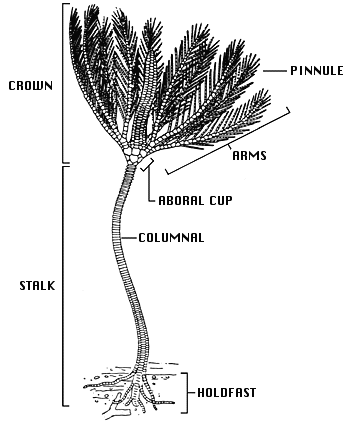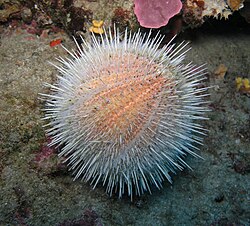Starfish possess a through gut with an anus with a headless body that can vary in shape. They have a poorly defined open circulatory system but a fairly good nervous system with a circum-oesophageal ring. Starfish feed on fine particles of the water, detritus, or even other animals. Their diet includes oysters and clams and proves to make Starfish a pest of commercial clam and oyster beds. Interestingly, species of the phylum Echinodermata possess no excretory organs. Species of Starfish can reproduce by means of sexual reproduction and gonochoristic reproduction.
There are five living classes:
Crinoidea: Includes Sea lilies, Feather stars, and comatulids.

Image of Crinoidea structure from http://tolweb.org/tree/ToLimages/crinoid.gif
Ophiocistioidea: A class of extinct echinoderms from the Palaeozoic. They had a body structure similar to that of a sea urchin.

Image of Ophiocistioidea fossil from http://www.geomuseum.uni-goettingen.de/people/mreich/pdf/images/neuweb_seegurken11.gif
Astroidea: Harmless algal grazers and detrivores. Includes Starfish.

Image of Astroidea Starfish from http://www.reefs.org/hhfaq/starfish/star.jpg/view
Echinoiudea: Includes Sea urchins, which are spiny, globular animals. Sand dollars are closely related.

Image of Sea urchin from http://upload.wikimedia.org/wikipedia/commons/thumb/4/4b/Riccio_Melone_a_Capo_Caccia_adventurediving.it.jpg/250px-Riccio_Melone_a_Capo_Caccia_adventurediving.it.jpg
Holothuoidea: Includes Sea cucumbers, which have leathery skin and an elongated body containing a single, branched gonad.

Image of Sea cucumber from http://en.wikipedia.org/wiki/File:Espardenya_(animal).jpg
No comments:
Post a Comment